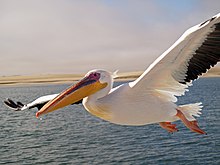
Back Pelikaan Afrikaans Dūfedoppa ANG بجعة Arabic ܩܩܐ ARC بجعه ARZ Pelecanus AST Qutan Azerbaijani قوتان AZB Берғаҙан Bashkir Пеліканы Byelorussian
| Pelican | |
|---|---|

| |
| A great white pelican in breeding condition flying over Walvis Bay, Namibia. | |
| Scientific classification | |
| Domain: | Eukaryota |
| Kingdom: | Animalia |
| Phylum: | Chordata |
| Class: | Aves |
| Order: | Pelecaniformes |
| Family: | Pelecanidae |
| Genus: | Pelecanus Linnaeus, 1758 |
| Type species | |
| Pelecanus onocrotalus Linnaeus, 1758
| |
| Species | |
|
8, see text | |
Pelicans (genus Pelecanus) are a genus of large water birds that make up the family Pelecanidae. They are characterized by a long beak and a large throat pouch used for catching prey and draining water from the scooped-up contents before swallowing. They have predominantly pale plumage, except for the brown and Peruvian pelicans. The bills, pouches, and bare facial skin of all pelicans become brightly coloured before the breeding season.
The eight living pelican species have a patchy, seasonally-dependent yet global distribution, ranging latitudinally from the tropics to the temperate zone. Pelicans are absent from interior Amazonian South America, from polar regions and the open ocean; at least one species is known to migrate to the inland desert of Australia's Red Centre, after heavy rains create temporary lakes. White pelicans are also observed at the American state of Utah's Great Salt Lake, for example, some 600 miles (965 km) from the nearest coastline (the Pacific West Coast). They have also been seen hundreds of miles inland in North America, having flown northwards along the Mississippi River and other large waterways.
Long thought to be related to frigatebirds, cormorants, tropicbirds, and gannets and boobies, pelicans instead are most closely related to the shoebill and hamerkop storks (although these two birds are not actually true 'storks'), and are placed in the order Pelecaniformes. Ibises, spoonbills, herons, and bitterns have been classified in the same order. Fossil evidence of pelicans dates back at least 36 million years to the remains of a tibiotarsus recovered from late Eocene strata of Egypt that bears striking similarity to modern species of pelican.[1] They are thought to have evolved in the Old World and spread into the Americas; this is reflected in the relationships within the genus as the eight species divide into Old World and New World lineages.[3] This hypothesis is supported by fossil evidence from the oldest pelican taxa.[1]

Pelicans will frequent inland waterways but are most known for residing along maritime and coastal zones, where they feed principally on fish in their large throat pouches, diving into the water and catching them at/near the water's surface. They can adapt to varying degrees of water salinity, from freshwater and brackish to—most commonly—seawater. They are gregarious birds, travelling in flocks, hunting cooperatively, and breeding colonially. Four white-plumaged species tend to nest on the ground, and four brown or grey-plumaged species nest mainly in trees.[4] The relationship between pelicans and people has often been contentious. The birds have been persecuted because of their perceived competition with commercial and recreational fishing.[5] Their populations have fallen through habitat destruction, disturbance, and environmental pollution, and three species are of conservation concern. They also have a long history of cultural significance in mythology, and in Christian and heraldic iconography.
- ^ a b c El Adli, Joseph J.; Wilson Mantilla, Jeffrey A.; Antar, Mohammed Sameh M.; Gingerich, Philip D. (2 January 2021). "The earliest recorded fossil pelican, recovered from the late Eocene of Wadi Al-Hitan, Egypt". Journal of Vertebrate Paleontology. 41 (1): e1903910. Bibcode:2021JVPal..41E3910E. doi:10.1080/02724634.2021.1903910. ISSN 0272-4634. S2CID 236269386.
- ^ Kuhl., H.; Frankl-Vilches, C.; Bakker, A.; Mayr, G.; Nikolaus, G.; Boerno, S. T.; Klages, S.; Timmermann, B.; Gahr, M. (2020). "An unbiased molecular approach using 3'UTRs resolves the avian family-level tree of life". Molecular Biology and Evolution. 38: 108–127. doi:10.1093/molbev/msaa191. PMC 7783168. PMID 32781465.
- ^ Cite error: The named reference
kennedywas invoked but never defined (see the help page). - ^ Cite error: The named reference
NSSwas invoked but never defined (see the help page). - ^ Cite error: The named reference
Keith05was invoked but never defined (see the help page).